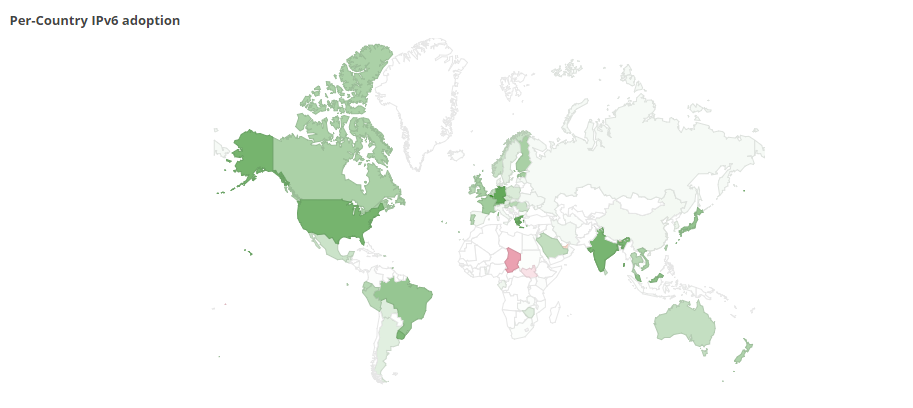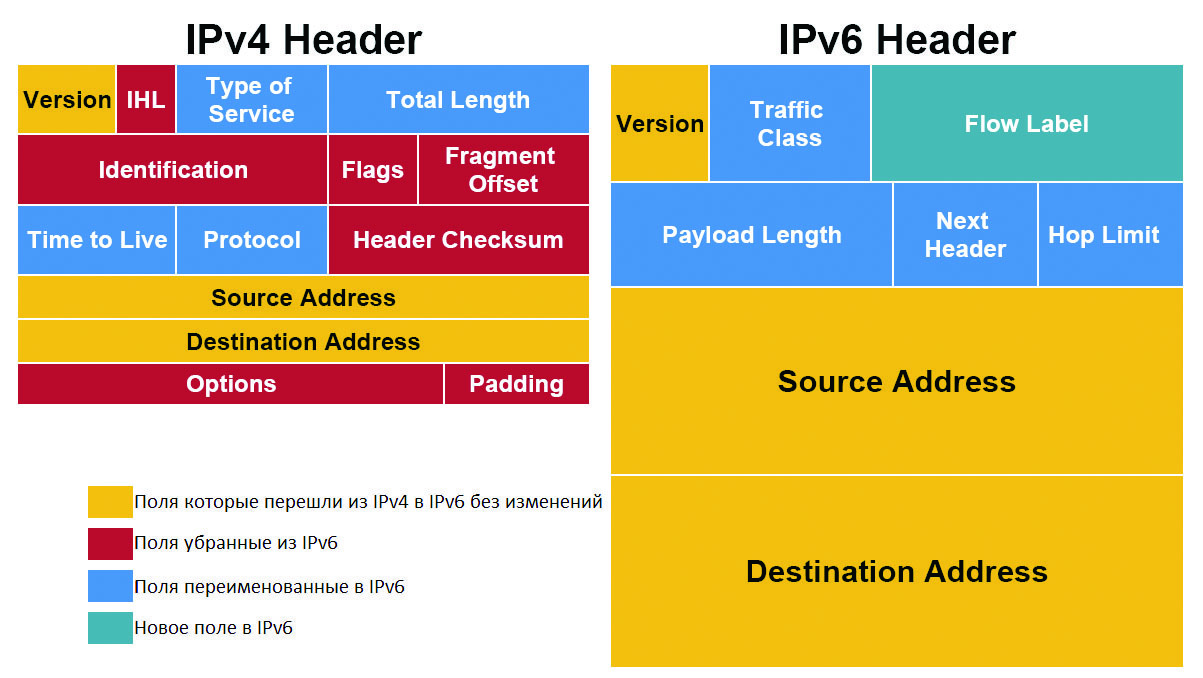Google users have crossed the 25% milestone in the number of IPv6 connections
The day before yesterday, October 13, 2018, a rather significant event took place. According to Google open statistics , the total number of IPv6 connections to the company's servers has exceeded 25%. Now this figure is 25.04%. Considering the mass nature of Google and the company's presence in all major markets except China, these statistics can be called “moderately relevant” and, on its basis, state that the world is gradually moving towards IPv6 puncture with IPv4, which addresses are seriously lacking.

IPv6 Prevalence Map
The most active countries in using the IPv6 protocol are Belgium (52.68%), Germany (39.14%), Greece (36.53%). The United States (34.23%), India (33.51%), Uruguay (32.45%) and Malaysia (28.89%) are behind the troika with a slight lag. But the innovative Japan, which is obvious to everyone, is behind these countries with an indicator of ~ 26.72%. You can still highlight Canada, France, Finland, Brazil, Peru, Saudi Arabia and even Ecuador. But in areas outside of Europe and both Americas, things are much worse. In the CIS, IPv6 is almost never used (<1% of connections).
The fact that sooner or later we will have to switch to the IPv6 protocol, the community actively started talking in 2011-2014, when news of the physical ending of the IPv4 address pool began to appear in large numbers. By the way, this news and reasoning did not pass by Habr, here are some of them in search .

Growth in the number of IPv6 connections according to Google statistics
The most acute problem of reducing the pool of IPv4 addresses has become with the development of the IoT devices markethaving a direct connection to the Internet bypassing local routers and other access points. We are talking about smart home technologies, remote control devices and even gate relay control modules, which often use the mobile Internet instead of Wi-Fi technology. Also, “smart” devices with direct access to the Internet are ubiquitous in areas such as security and fire alarm systems, and use the SIM card of mobile operators as a communication module.
Previously used half measures as NAT networks, with which providers shut down users from the outside world, led to serious inconveniences in 2012-2014, when Google perceived NAT as a botnet. Also, users suffered if in the same NAT network with them turned out to be infected devices sending automatic requests via a single external IP address. We think that many residents of the CIS, sitting behind NAT, faced similar messages at that time.

IPv6 technology has been around for more than 20 years, but it began to receive obvious distribution only in the last five years, when providers faced the problem of lack of real ip-addresses. The main reason for not wanting to implement IPv6 is the banal inertia and following at the highest levels of the holy and overriding commandments of any network engineer: “Does it work? Do not touch!". Of course, the complexity of the IPv6 addresses themselves visually played a significant role. The vast majority of network infrastructures are still managed and maintained in manual or semi-automatic mode, when the engineer supporting it needs to enter addresses manually. And dooming people to work with addresses like 2001: 9db8: 11b4: 09d7: 1f34: 8a2e: 07a1: 541c instead of 192.104.22.12 looks at least inhumane. At the same time, the fact that NAT is not a panaceaargued on Habré in 2011, giving quite understandable and obvious arguments in favor of IPv6.
But the most obvious reason for not wanting to implement IPv6 everywhere is the banal lack of the necessary number of specialists to ensure the smooth and safe operation of such networks. In addition to a larger number of addresses (namely, 2 ^ 128), the architecture of a packet in the IPv6 protocol differs significantly from that in IPv4. Compared to its predecessor, many things in IPv6 have become optional and are in the extension header . Here is a comparison of the IPv4 and IPv6 packet header structure:

Due to optimization, in IPv6 packets, many things that did not directly affect routing were rendered in the extension header. This has greatly accelerated the work of the IPv6 network, but brought its own problems. So, the IPv6 architecture has generated new vectors for network and LAN attacks, which are guided by the same principles that were used for IPv4 networks. At the same time, IPv6 makes it difficult to control and monitor traffic, which, of course, does not suit providers that provide limited access to the network. In detail and with taste about the technical features of IPv6, the pros and cons, wrote the magazine "Hacker" in his blog on Habré (when they were still here), you can read (and recommend) this link .
In conclusion, it should be said that over the past ten years we have witnessed a massive preparation for the introduction of IPv6 and the transition to its immediate and widespread use. The vast majority of modern devices and operating systems support IPv6 out of the box, and manufacturers of marshutizers and other infrastructure equipment are not far behind. The statistics provided by Google at the beginning of the publication is only a logical consequence of these events, which stretched over so many years. It is quite possible that while maintaining the current dynamics, we will cross the milestone of 50% of IPv6 connections already at the beginning of the next decade.

IPv6 Prevalence Map
The most active countries in using the IPv6 protocol are Belgium (52.68%), Germany (39.14%), Greece (36.53%). The United States (34.23%), India (33.51%), Uruguay (32.45%) and Malaysia (28.89%) are behind the troika with a slight lag. But the innovative Japan, which is obvious to everyone, is behind these countries with an indicator of ~ 26.72%. You can still highlight Canada, France, Finland, Brazil, Peru, Saudi Arabia and even Ecuador. But in areas outside of Europe and both Americas, things are much worse. In the CIS, IPv6 is almost never used (<1% of connections).
The fact that sooner or later we will have to switch to the IPv6 protocol, the community actively started talking in 2011-2014, when news of the physical ending of the IPv4 address pool began to appear in large numbers. By the way, this news and reasoning did not pass by Habr, here are some of them in search .

Growth in the number of IPv6 connections according to Google statistics
The most acute problem of reducing the pool of IPv4 addresses has become with the development of the IoT devices markethaving a direct connection to the Internet bypassing local routers and other access points. We are talking about smart home technologies, remote control devices and even gate relay control modules, which often use the mobile Internet instead of Wi-Fi technology. Also, “smart” devices with direct access to the Internet are ubiquitous in areas such as security and fire alarm systems, and use the SIM card of mobile operators as a communication module.
Previously used half measures as NAT networks, with which providers shut down users from the outside world, led to serious inconveniences in 2012-2014, when Google perceived NAT as a botnet. Also, users suffered if in the same NAT network with them turned out to be infected devices sending automatic requests via a single external IP address. We think that many residents of the CIS, sitting behind NAT, faced similar messages at that time.

Why so slow?
IPv6 technology has been around for more than 20 years, but it began to receive obvious distribution only in the last five years, when providers faced the problem of lack of real ip-addresses. The main reason for not wanting to implement IPv6 is the banal inertia and following at the highest levels of the holy and overriding commandments of any network engineer: “Does it work? Do not touch!". Of course, the complexity of the IPv6 addresses themselves visually played a significant role. The vast majority of network infrastructures are still managed and maintained in manual or semi-automatic mode, when the engineer supporting it needs to enter addresses manually. And dooming people to work with addresses like 2001: 9db8: 11b4: 09d7: 1f34: 8a2e: 07a1: 541c instead of 192.104.22.12 looks at least inhumane. At the same time, the fact that NAT is not a panaceaargued on Habré in 2011, giving quite understandable and obvious arguments in favor of IPv6.
But the most obvious reason for not wanting to implement IPv6 everywhere is the banal lack of the necessary number of specialists to ensure the smooth and safe operation of such networks. In addition to a larger number of addresses (namely, 2 ^ 128), the architecture of a packet in the IPv6 protocol differs significantly from that in IPv4. Compared to its predecessor, many things in IPv6 have become optional and are in the extension header . Here is a comparison of the IPv4 and IPv6 packet header structure:

Due to optimization, in IPv6 packets, many things that did not directly affect routing were rendered in the extension header. This has greatly accelerated the work of the IPv6 network, but brought its own problems. So, the IPv6 architecture has generated new vectors for network and LAN attacks, which are guided by the same principles that were used for IPv4 networks. At the same time, IPv6 makes it difficult to control and monitor traffic, which, of course, does not suit providers that provide limited access to the network. In detail and with taste about the technical features of IPv6, the pros and cons, wrote the magazine "Hacker" in his blog on Habré (when they were still here), you can read (and recommend) this link .
In conclusion, it should be said that over the past ten years we have witnessed a massive preparation for the introduction of IPv6 and the transition to its immediate and widespread use. The vast majority of modern devices and operating systems support IPv6 out of the box, and manufacturers of marshutizers and other infrastructure equipment are not far behind. The statistics provided by Google at the beginning of the publication is only a logical consequence of these events, which stretched over so many years. It is quite possible that while maintaining the current dynamics, we will cross the milestone of 50% of IPv6 connections already at the beginning of the next decade.
Only registered users can participate in the survey. Sign in , please.
